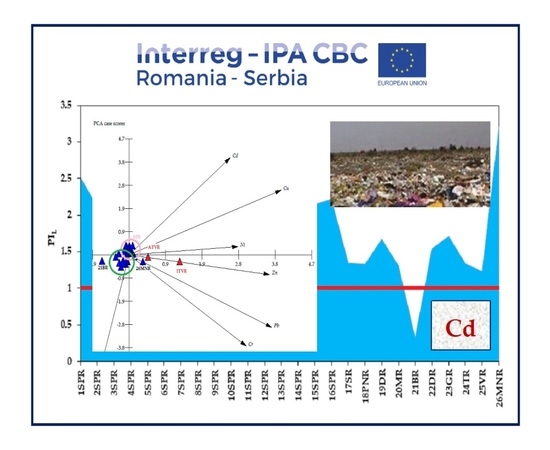An Innovative Approach to Assess the Ecotoxicological Risks of Soil Exposed to Solid Waste
Abstract
1. Introduction
2. Materials and Methods
2.1. A-Study
2.2. B-Study
2.2.1. Data about Soil Collection Areas
2.2.2. Sampling and Soil Samples Preparation
2.2.3. Elemental Analysis
2.2.4. Ecological Risk Assessment
Soil Contamination Factor (CF)
Pollution Index of Soil Loadings (PIL)
Potential Ecological Risk Assessment (RI)
2.2.5. Mathematical Analysis and Modelling
3. Results and Discussion
4. Conclusions
Author Contributions
Funding
Institutional Review Board Statement
Informed Consent Statement
Data Availability Statement
Conflicts of Interest
References
- Council Directive 75/442/EEC of 15 July 1975 on Waste. OJ L 1975, 194, 39–41. Available online: https://eur-lex.europa.eu/legal-content/EN/TXT/?uri=CELEX%3A31975L0442 (accessed on 25 January 2021).
- Law No. 265/2006 for the Approval of the Government Emergency Ordinance no. 195/2005 on Environmental Protection, Published in the Official Gazette of Romania, No. 586/6 July. 2006. Available online: https://lege5.ro/gratuit/ha3tambq/legea-nr-265-2006-pentru-aprobarea-ordonantei-de-urgenta-a-guvernului-nr-195-2005-privind-protectia-mediului (accessed on 19 February 2021).
- Pfeffer, J.T. Solid Waste Management Engineering; Prentice Hall: Englewood Cliffs, NJ, USA, 1992. [Google Scholar]
- Order of the Ministry of Agriculture, Food and Forests No. 223, updated and published in Official Gazette of Romania No. 598/13 August, Bucharest, Romania. 2002. Available online: http://legislatie.just.ro/Public/DetaliiDocument/37981 (accessed on 12 March 2021).
- Government Decision on Waste Management Records and for the Approval of the List Containing Waste, Including Hazardous Waste No. 856/2002, Published in the Official Gazette of Romania No. 659/5 September. 2002. Available online: http://legislatie.just.ro/Public/DetaliiDocument/38294 (accessed on 21 January 2021).
- Volunteers Pick up Litter in Sabana Park. Available online: https://www.insidecostarica.com/dailynews/2010/december/20/costarica10122006.htm (accessed on 17 January 2021).
- Learn the Basics of Hazardous Waste. Available online: https://www.epa.gov/hw/learn-basics-hazardous-waste (accessed on 14 February 2021).
- What Are the RCRA 8 Metals? Available online: https://www.ecoflo.com/2014/12/19/what-are-the-rcra-8-metals/ (accessed on 4 March 2021).
- Orlescu, C.M.; Costescu, I.A. Solid waste management in Romania: Current and future issues. Environ. Eng. Manag. J. 2013, 12, 891–899. Available online: http://www.eemj.icpm.tuiasi.ro/pdfs/vol12/no5/6_278_Orlescu_13.pdf (accessed on 10 March 2021).
- Waste Framework Directive (2008/98/EC). Available online: http://eur-lex.europa.eu/LexUriServ/LexUriServ.do?uri=CELEX:32008L0098:EN:NOT (accessed on 14 May 2021).
- Integrated Waste Management System in Timis County—Report on the Environmental Impact Assessment Study. Available online: http://arpmtm.anpm.ro/files/ARPM%20TIMISOARA/Reglementari/Acordul%20de%20mediu/Rapoarte%202011/rsitimisrev1.pdf (accessed on 15 May 2021).
- European Commission DG ENV. E3: Heavy Metals in Waste, Final Report. Project ENV.E.3/ETU/2000/0058, COWI A/S, Denmark 2002. Available online: https://fayllar.org/european-commission-dg-env-e3.html (accessed on 18 May 2021).
- Conducting an Ecological Risk Assessment. Available online: https://www.epa.gov/risk/conducting-ecological-risk-assessment#tab (accessed on 19 March 2021).
- Guidelines for Ecological Risk Assessment, EPA/630/R-95/002F, April 1998, Published on 14 May 1998, Federal Register 63(93):26846–26924. Available online: https://www.epa.gov/sites/production/files/2014-11/documents/eco_risk_assessment1998.pdf (accessed on 13 May 2021).
- European Parliament 2009–2014, Petition 1215/2011 by Jean Pierre Pascal, Concerning the Discharge of Industrial Waste in a Landfill Site in Parta-Sag, Timis County, Romania. Available online: https://www.europarl.europa.eu/doceo/document/PETI-CM-492732_EN.pdf?redirect (accessed on 14 May 2021).
- Comuna Bolvasnita. Asezare Geografica si Clima. Available online: http://www.primaria-bolvasnita.ro/geografie (accessed on 25 March 2021).
- Timisoara. Available online: https://www.britannica.com/place/Timisoara (accessed on 1 April 2021).
- Date Istorico-Geografice Comuna Varias Judetul Timis. Available online: http://primaria-varias.ro/date-istorico-geografice-comuna-varias-judetul-timis/ (accessed on 29 March 2021).
- Enciclopedia Romaniei. Moldova Nouă. Available online: http://enciclopediaromaniei.ro/wiki/Moldova_Nou%C4%83 (accessed on 11 March 2021).
- Nica, D.V.; Bordean, D.M.; Pet, I.; Pet, E.; Alda, S.; Gergen, I. A novel exploratory chemometric approach to environmental monitorring by combining block clustering with Partial Least Square (PLS) analysis. Chem. Cent. J. 2013, 7, 1–10. Available online: https://link.springer.com/article/10.1186/1752-153X-7-145#Sec4 (accessed on 15 March 2021). [CrossRef]
- Bordean, D.M.; Borozan, A.B.; Nica, D.; Alda, S.; Cojocaru, L.; Horablaga, M.; Gergen, I. Assessment of soil, copper, cobalt and chromium contamination in old mining areas from Romania. In Proceedings of the International Multidisciplinary Scientific GeoConference: SGEM, Albena, Bulgaria, 17–23 June 2012; STEF92 Technology Ltd.: Sofia, Bulgaria, 2012; Volume 5, pp. 101–108. Available online: http://toc.proceedings.com/19962webtoc.pdf (accessed on 24 February 2021).
- Rudnick, R.L.; Gao, S. The Composition of the Continental Crust. In Treatise of Geochemistry; Holland, H.D., Turekian, K.K., Eds.; Elsevier-Pergamon: Oxford, UK, 2003; Volume 3, pp. 1–64. [Google Scholar]
- Hakanson, L. An ecological risk index for aquatic pollution control. A sedimentological approach. Water Res. 1980, 14, 975–1001. [Google Scholar] [CrossRef]
- Tomlinson, D.C.; Wilson, D.J.; Harris, C.R.; Jeffrey, D.W. Problem in heavy metals in estuaries and the formation of pollution index. Helgol. Wiss. Meeresunter. 1980, 33, 566–575. Available online: https://hmr.biomedcentral.com/track/pdf/10.1007/BF02414780.pdf (accessed on 10 March 2021). [CrossRef]
- Alharbi, B.H.; Pasha, M.J.; Alotaibi, M.D.; Alduwais, A.K.; Al-Shamsi, M.A.S. Contamination and risk levels of metals associated with urban street dust in Riyadh, Saudi Arabia. Environ. Sci. Pollut. Res. 2020, 27, 18475–18487. [Google Scholar] [CrossRef]
- Muller, G. Schwermetalle in den sediments des Rheins: Veränderungen seit 1971. Umschan 1979, 79, 778–783. [Google Scholar]
- Khaled, A.; Abdel-Halim, A.; El-Sherif, Z.; Mohamed, L.A. Health risk assessment of some heavy metals in water and sediment at Marsa-Matrouh, Mediterranean Sea, Egypt. J. Environ. Prot. 2017, 8, 74–97. [Google Scholar] [CrossRef]
- Kumar, M.; Gogoi, A.; Kumari, D.; Borah, R.; Das, P.; Mazumder, P.; Tyagi, V.K. Review of perspective, problems, challenges, and future scenario of metal contamination in the urban environment. J. Hazard. Toxic Radioact. Waste 2017, 21, 04017007. [Google Scholar] [CrossRef]
- Kuerban, M.; Maihemuti, B.; Waili, Y.; Tuerhong, T. Ecological risk assessment and source identification of heavy metal pollution in vegetable bases of Urumqi, China, using the positive matrix factorization (PMF) method. PLoS ONE 2020, 15, e0230191. [Google Scholar] [CrossRef]
- Sulaiman, M.B.; Asegbeloyin, J.N.; Ihedioha, J.; Oyeka, E.E.; Oji, E.O. Trace Metals Content of Soil around a Municipal Solid Waste Dumpsite in Gombe, Nigeria: Assessing the Ecological and Human Health Impact. J. Chem. Health Risks 2019, 9, 173–190. [Google Scholar] [CrossRef]
- Vongdala, N.; Tran, H.D.; Xuan, T.D.; Teschke, R.; Khanh, T.D. Heavy metal accumulation in water, soil, and plants of municipal solid waste landfill in Vientiane, Laos. Int. J. Environ. Res. Public Health 2019, 16, 22. [Google Scholar] [CrossRef] [PubMed]
- Poznanović Spahić, M.M.; Sakan, S.M.; Glavaš-Trbić, B.M.; Tančić, P.I.; Škrivanj, S.B.; Kovačević, J.R.; Manojlović, D.D. Natural and anthropogenic sources of chromium, nickel and cobalt in soils impacted by agricultural and industrial activity (Vojvodina, Serbia). J. Environ. Sci. Health A 2019, 54, 219–230. [Google Scholar] [CrossRef]
- Romanian Law—Order 756/1997 for the Approval of the Regulation on the Assessment of Environmental Pollution, Regulations of 3 November 1997 (Updated by 28 June 2011), Ministry of Water, Forest and Environmental Protection. Available online: http://Legislatie.Just.Ro/Public/Detaliidocumentafis/151788 (accessed on 29 March 2021).
- Final Implementation Report for Directive 86/278/EEC on Sewage Sludge: 2013–2015. Available online: https://ec.europa.eu/environment/archives/waste/reporting/pdf/Final_Implementation_Report_2013_2015_Sewage_Sludge.pdf (accessed on 18 March 2021).
- Panagos, P.; Ballabio, C.; Lugato, E.; Jones, A.; Borrelli, P.; Scarpa, S.; Orgiazzi, A.; Montanarella, L. Potential sources of anthro-pogenic copper inputs to European agricultural soils. Sustainability 2018, 10, 2380. [Google Scholar] [CrossRef]
- Albulescu, M.; Popovici, H.; Turuga, L.; Masu, S.; Chiriac, A. Analysis of heavy metals content of soil and Vitis Vinifera in two vineyard areas of the Caras-Severin County, Romania. J. Environ. Prot. Ecol. 2012, 13, 48–55. Available online: http://www.elearning-chemistry.ro/awut/userfiles/magazine1_acc/37-44_Albulescu-Turuga.pdf (accessed on 11 February 2021).
- Teh, T.; Norulaini, N.A.R.N.; Shahadat, M.; Wong, Y.; Omar, A.K.M. Risk assessment of metal contamination in soil and groundwater in Asia: A review of recent trends as well as existing environmental laws and regulations. Pedosphere 2016, 26, 431–450. [Google Scholar] [CrossRef]
- Adelekan, B.A.; Alawode, A.O. Contributions of municipal refuse dumps to heavy metals concentrations in soil profile and groundwater in Ibadan Nigeria. J. Appl. Biosci. 2011, 40, 2727–2737. Available online: www.m.elewa.org/JABS/2011/40/7.pdf (accessed on 28 December 2020).
- Mouhoun-Chouaki, S.; Derridj, A.; Tazdaït, D.; Salah-Tazdaït, R. A study of the impact of municipal solid waste on some soil physicochemical properties: The case of the landfill of Ain-El-Hammam Municipality, Algeria. Appl. Environ. Soil Sci. 2019, 2019, 3560456. [Google Scholar] [CrossRef]
- Mekonnen, B.; Haddis, A.; Zeine, W. Assessment of the Effect of Solid Waste Dump Site on Surrounding Soil and River Water Quality in Tepi Town, Southwest Ethiopia. J. Environ. Public Health 2020, 2020, 5157046. [Google Scholar] [CrossRef]
- Anjanapriya, S.; Lalitha, S. Impacts of Heavy Metals in Soil Profile of Surrounding Municipal Solid Waste Dump Site. Int. J. Sci. Res. 2016, 5, 554–557. Available online: https://www.ijsr.net/archive/v5i5/3051603.pdf (accessed on 10 March 2021).
- Li, Y.; Zhou, S.; Jia, Z.; Ge, L.; Mei, L.; Sui, X.; Wang, X.; Li, B.; Wang, J.; Wu, S. Influence of Industrialization and Environmental Protection on Environmental Pollution: A Case Study of Taihu Lake, China. Int. J. Environ. Res. Public Health 2018, 15, 2628. [Google Scholar] [CrossRef]
- Commission of the European Communities, Brussels, 22.9.2006 SEC(2006)620 Commission Staff Working Document, Thematic Strategy for Soil Protection, Impact Assessment of the Thematic Strategy on Soil Protection {COM(2006)231 Final} {SEC(2006)1165}. Available online: https://ec.europa.eu/environment/archives/soil/pdf/SEC_2006_620.pdf (accessed on 15 March 2021).
- Prieto, M.J.; Acevedo, S.O.A.; Prieto, G.F.; González, N.T. Phytoremediation of soils contaminated with heavy metals. Biodivers. Int. J. 2018, 2, 362–376. [Google Scholar] [CrossRef]
- EU Waste Management Law. Available online: https://eur-lex.europa.eu/legal-content/EN/TXT/?uri=LEGISSUM%3Aev0010 (accessed on 1 April 2021).
- Yamashita, B.; French, M. Latent Print Development. In The Fingerprint Sourcebook; McRoberts, A., McRoberts, D., Eds.; National Institute of Justice: Washington, DC, USA, 2011; pp. 155–222. [Google Scholar]
- Nordic Council of Ministers. Cadmium Review; WHO: Geneva, Switzerland, 2003; p. 11. Available online: https://www.who.int/ifcs/documents/forums/forum5/nmr_cadmium.pdf (accessed on 18 November 2020).

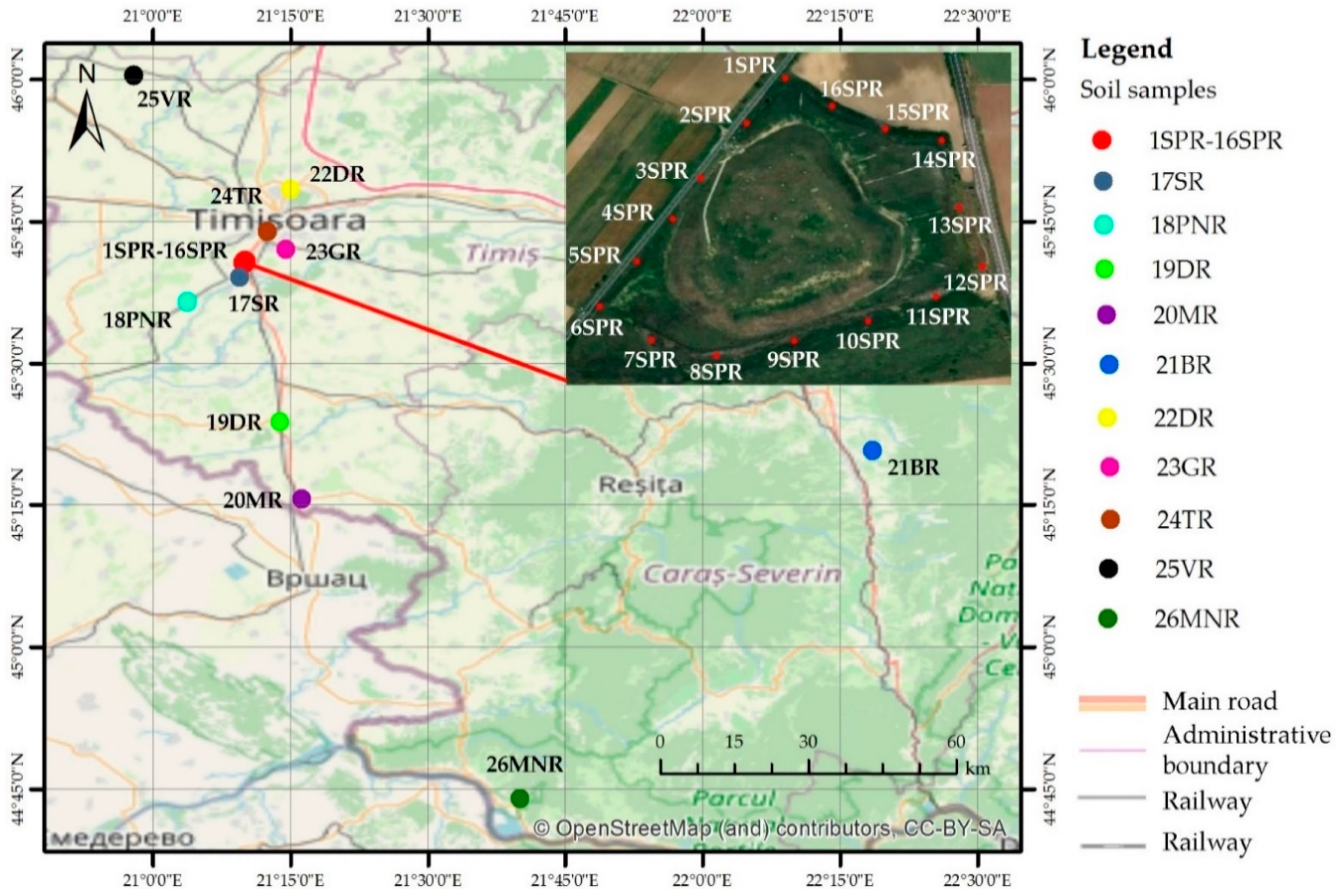

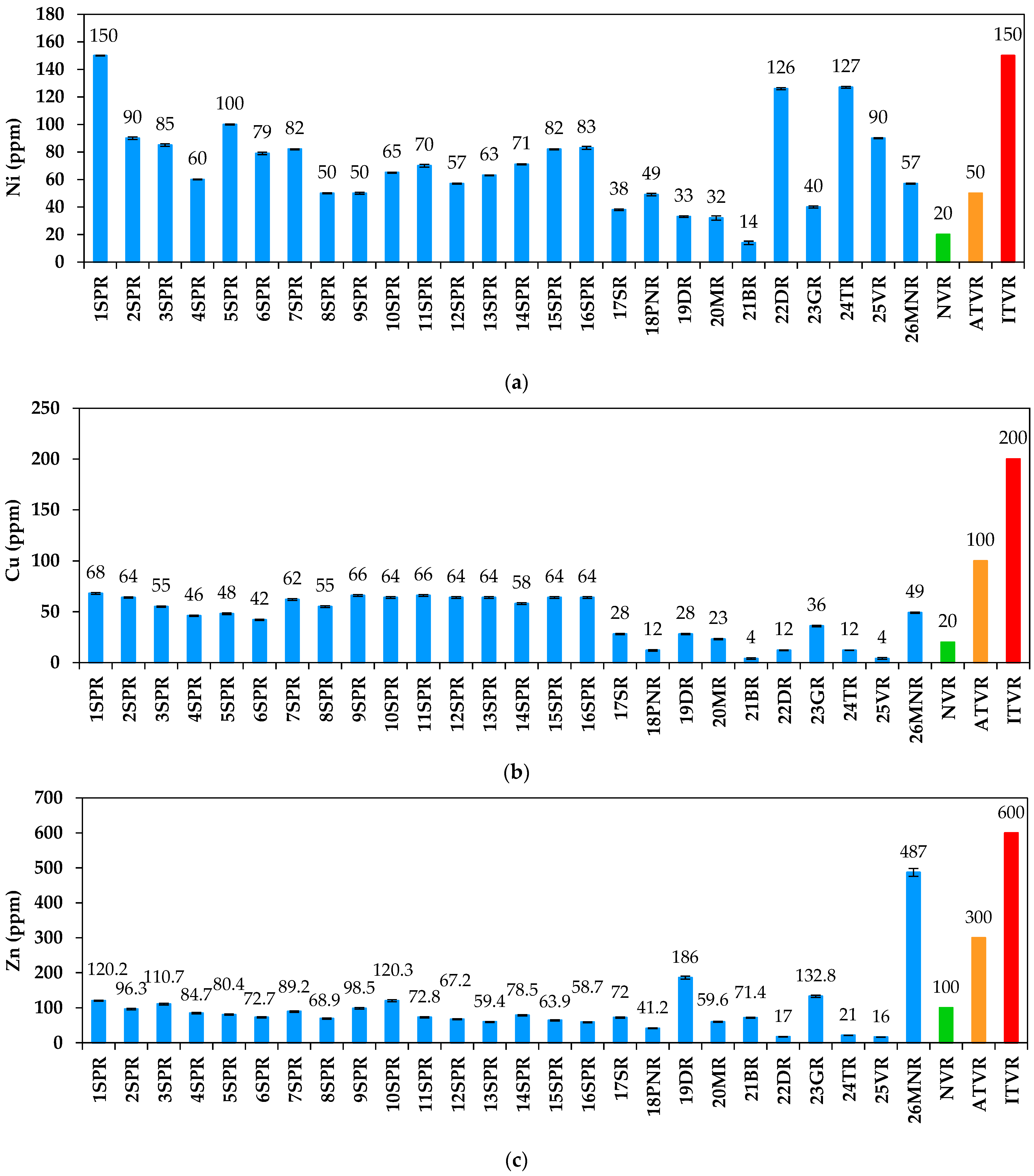



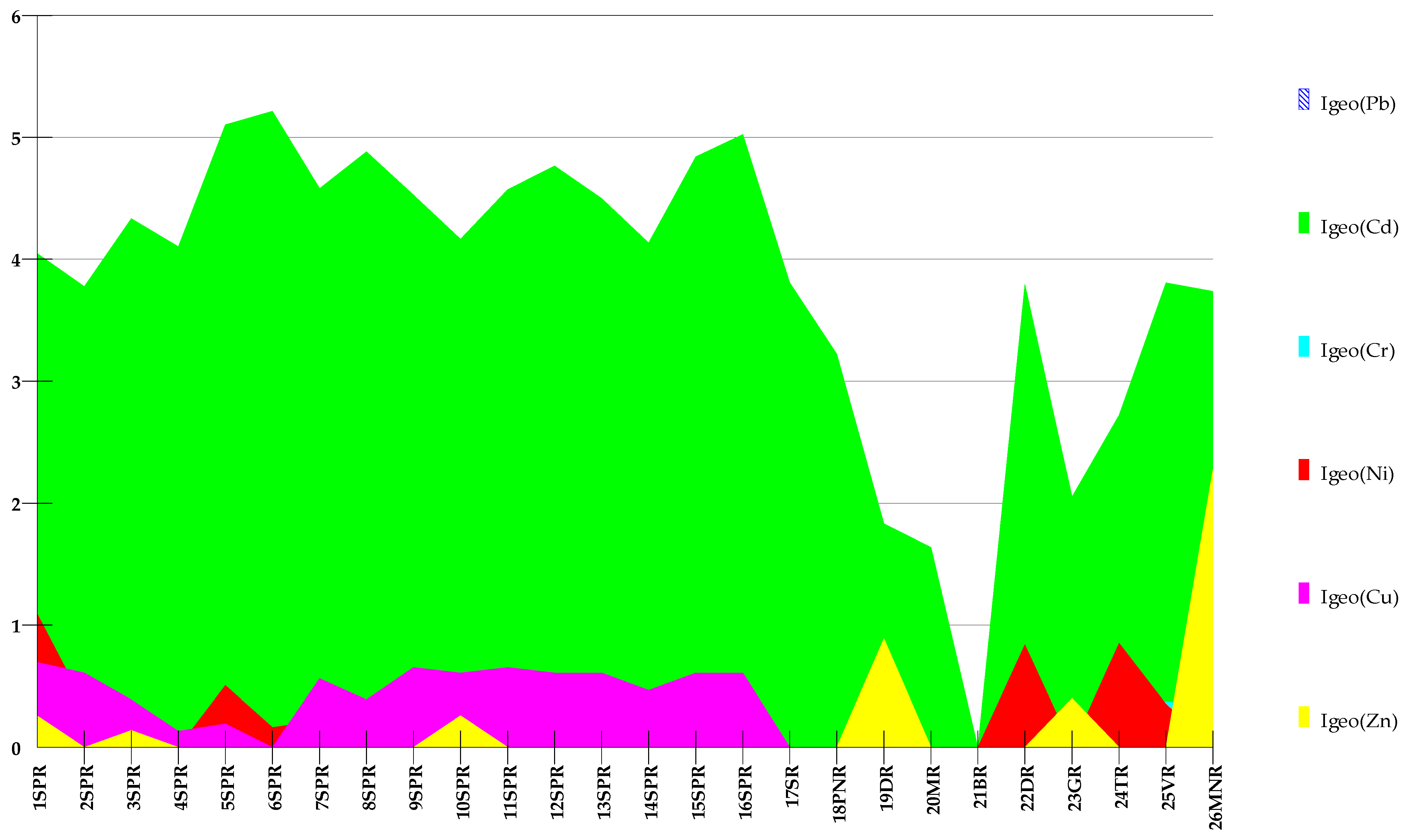
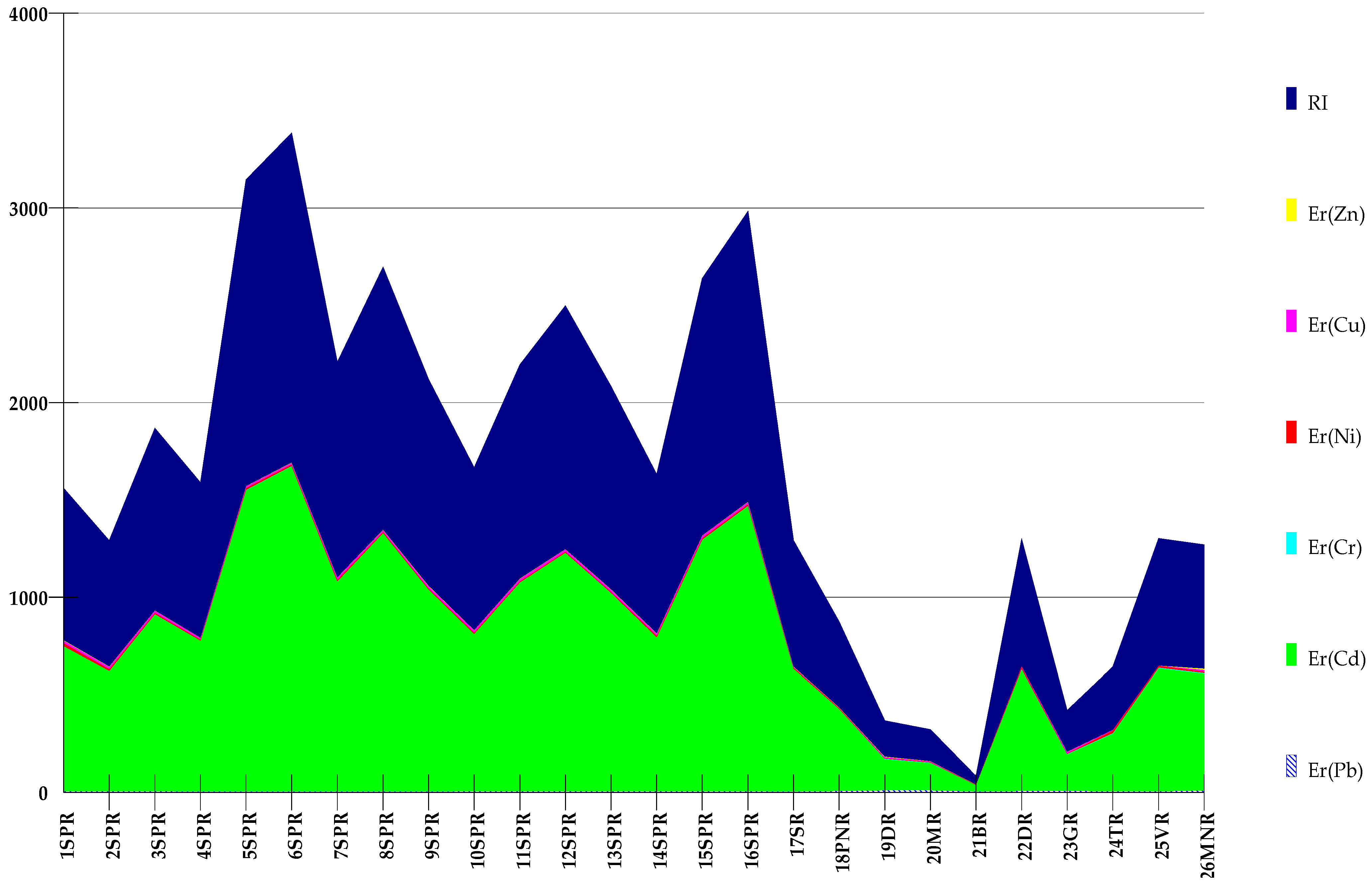
| Heavy Metal | As | Ba | Cd | Cr | Pb | Hg | Se | Ag |
|---|---|---|---|---|---|---|---|---|
| EPA Allowable Limits (ppm) | 5.0 | 100.0 | 1.0 | 5.0 | 5.0 | 0.2 | 1.0 | 5.0 |
| Soil Collection Areas | GPS Coordinates in WGS 84 SYSTEM | Soil Sample Code | Year of Sampling | Area Description | |
|---|---|---|---|---|---|
| Sag-Parta, Romania (closed landfill since 2008) | 45°40′50″ N | 21°9′57″ E | 1SPR | 2007 | A large area of 17 ha was occupied by the landfill of Timisoara until 2008, when it was closed. The location did not have the necessary arrangements for a controlled ramp, was not waterproofed, and did not have controlled water leaks or monitoring systems for gas and groundwater. Currently, the municipal waste is selectively collected and composted. |
| 45°40′47″ N | 21°9′55″ E | 2SPR | |||
| 45°40′44″ N | 21°9′52″ E | 3SPR | |||
| 45°40′41″ N | 21°9′50″ E | 4SPR | |||
| 45°40′38″ N | 21°9′47″ E | 5SPR | |||
| 45°40′36″ N | 21°9′45″ E | 6SPR | |||
| 45°40′42″ N | 21°10′8″ E | 7SPR | |||
| 45°40′46″ N | 21°10′7″ E | 8SPR | |||
| 45°40′47″ N | 21°10′3″ E | 9SPR | |||
| 45°40′48″ N | 21°10′1″ E | 10SPR | |||
| 45°40′33″ N | 21°9′58″ E | 11SPR | |||
| 45°40′32″ N | 21°9′53″ E | 12SPR | |||
| 45°40′33″ N | 21°9′48″ E | 13SPR | |||
| 45°40′36″ N | 21°10′7″ E | 14SPR | |||
| 45°40′38″ N | 21°10′10″ E | 15SPR | |||
| 45°40′35″ N | 21°10′2″ E | 16SPR | |||
| Sag, Romania | 45°39′4″ N | 21°9′25″ E | 17SR | 2016 | Sag is located at a distance of 3 km from landfill. Sag is a plain commune located at a distance of 13 km from Timisoara, on the national road DN59 Timisoara-Moravita, the European road E70. The samples were collected from the recreational area situated between Timis River and the main road, a potential trap for paper, cigarette butts, and plastic. |
| Peciu Nou, Romania | 45°36′26″ N | 21°3′42″ E | 18PNR | 2016 | Peciu Nou is located 16 km from Sag and 23 km from Timisoara. The soil samples were collected from the area close to the main road DJ593, where litter was observable. |
| Deta, Romania | 45°23′44″ N | 21°13′47″ E | 19DR | 2016 | Deta is located 30 km from Sag and 44 km from Timisoara on the national road DN59 Timisoara-Moravita, the European road E70. The soil samples were collected from the area close to the main road DN59, where litter was observable. |
| Moravita, Romania | 45°15′35″ N | 21°16′10″ E | 20MR | 2016 | Moravita is located 50 km from Sag and 61 km from Timisoara on the national road DN59 Timisoara-Moravita, the European road E70. The soil samples were collected from the area close to the main road DN59, where litter was observable. |
| Bolvasnita, Romania | 45°20′44″ N | 22°18′31″ E | 21BR | 2016 | Bolvasnita is a village located south of Caransebes, Caras-Severin county, at a distance of about 15 km, and at the western foot of Small Mountain (Muntele Mic) [16]. The soil samples were collected from the area close to the main road DJ608C, where litter was observable. |
| Dumbravita, Romania | 45°48′23″ N | 21°14′57″ E | 22DR | 2015 | Dumbravita village is located in a plain area, 6 km from Timisoara. The soil samples were collected from an area with illegal waste dumps formed mainly of construction materials. |
| Giroc, Romania | 45°41′59″ N | 21°14′26″ E | 23GR | 2015 | Giroc village is located in a plain area, 7 km from Timisoara. The soil samples were collected from an area with illegal waste dumps formed mainly of construction materials. |
| Timisoara, Romania | 45°43′53″ N | 21°12′25″ E | 24TR | 2017 | Timisoara is the capital of Timis county, one of the most important cities in western Romania, and located in the Pannonian Plain, near the divergence of the Timis and Bega rivers [17]. The soil samples were collected from an area close to DN59, a road characterized by large traffic volumes. |
| Varias, Romania | 46°0′23″ N | 20°57′51″ E | 25VR | 2012 | Varias commune is part of the territory of Timis county and is located in the northwestern part of the county. It is located at a distance of 45 km from Timisoara, 50 km from Arad municipality, and 30 km from Sinnicolau-Mare city [18]. The soil samples were collected from an area close to the main road DJ692 where litter was observed. |
| Moldova Noua, Romania | 44°43′57″ N | 21°40′1″ E | 26MNR | 2017 | Moldova Noua is a small city in southwestern Romania in Caras-Severin County, in an area known as Clisura Dunarii. It is located on the shores of the river Danube [19]. The soil samples were collected from an area with illegal domestic waste dumps. |
| Sample Site | Symbol | Heavy Metals Concentration (ppm) | |||||
|---|---|---|---|---|---|---|---|
| Pb | Cd | Cr | Ni | Cu | Zn | ||
| Upper Earth Crust | UEC | 17 | 0.09 | 92 | 47 | 28 | 67 |
| Classes of Contamination | CF | Contamination Level |
|---|---|---|
| I | CF < 1 | Low pollution |
| II | 1 < CF < 3 | Moderate pollution |
| III | 3 < CF < 6 | High pollution |
| IV | CF > 6 | Very high pollution |
| Classes of Contamination | PIL | Contamination Level |
|---|---|---|
| I | PIL < 1 | No contamination with the studied metals |
| II | PIL = 1 | Baseline levels of pollutants are present |
| III | PIL > 1 | Deterioration of site quality, the heavy metal Concentrations are above the permissible level |
| Class | Igeo | Contamination Level |
|---|---|---|
| I | Igeo ≤ 0 | no contamination |
| II | 0 < Igeo ≤ 1 | light to moderate |
| III | 1 < Igeo ≤ 2 | moderate |
| IV | 2 < Igeo ≤ 3 | moderate to heavy |
| V | 3 < Igeo ≤ 4 | heavy |
| VI | 4 < Igeo ≤ 5 | heavy to extremely serious |
| VII | Igeo ≥ 5 | extremely serious |
| HM | |
|---|---|
| Pb | 5 |
| Cd | 30 |
| Cr | 2 |
| Ni | 5 |
| Cu | 5 |
| Zn | 1 |
| Grades | RI | Class of Ecological Risk | |
|---|---|---|---|
| I | < 40 | RI < 110 | Low potential ecological risk |
| II | 40 ≤< 80 | 110 ≤ RI < 220 | Moderate potential risk |
| III | 80 ≤< 160 | 220 ≤ RI < 440 | Considerable potential risk |
| IV | 160 ≤< 320 | 440 ≤ RI < 880 | High potential risk |
| V | ≥ 320 | 800 ≤ RI | Significantly very high |
| Values (ppm) | Symbol | Pb | Cd | Cr | Ni | Cu | Zn |
|---|---|---|---|---|---|---|---|
| Normal values for Romania | NVR | 20 | 1 | 30 | 20 | 20 | 100 |
| Alert threshold values for Romania * | ATVR | 50 | 3 | 100 | 75 (50 *) | 100 | 300 |
| Intervention threshold values for Romania | ITVR | 100 | 5 | 300 | 150 | 200 | 600 |
| Values (ppm) | Symbol | Pb | Cd | Cr | Ni | Cu | Zn |
|---|---|---|---|---|---|---|---|
| Normal value for the Netherlands * | NVN | 50 | 1 | 100 | 50 | 50 | 200 |
| Investigation is required * | IRN | 150 | 5 | 250 | 100 | 100 | 500 |
| Cleanup is required * | CRN | 600 | 20 | 800 | 500 | 500 | 3000 |
| Target value in the Netherlands ** | TVN | 85 | 0.8 | 100 | 35 | 36 | 140 |
| Intervention value in the Netherlands ** | ITVN | 530 | 12 | 380 | 210 | 190 | 720 |
| Maximum Identified CF(HM) Value | CF(Pb) | CF(Cd) | CF(Cr) | CF(Ni) | CF(Cu) | CF(Zn) |
|---|---|---|---|---|---|---|
| Landfill | ||||||
| Romania Sag-Parta (B-Study) | 2.12 | 55.67 | 1.95 | 3.19 | 2.43 | 7.28 |
| Other investigated References (A-Study) | ||||||
| (**) Nigeria (Ibadan) [38] | 41.75 | 181.11 | 2.15 | 1.50 | 58.27 | 38.90 |
| Alger (Hammam) [39] | 3.55 | 17.78 | 0.83 | 0.90 | 2.86 | 1.39 |
| Ethiopia (Tepi) [40] | 3.39 | 25.11 | - | - | 10.22 | 12.83 |
| India (Madurai Tamilnandu) [41] | - | 171.67 | 2.15 | 1.50 | 7.46 | 5.65 |
| (**) Multiple | 19.71 | 3.25 | 1.10 | 0.47 | 23.99 | 5.35 |
| Country/Site | PIL | Igeo (Pb) | Igeo (Cd) | Igeo (Cr) | Igeo (Ni) | Igeo (Cu) | Igeo (Zn) | Er (Pb) | Er (Cd) | Er (Cr) | Er (Ni) | Er (Cu) | Er (Zn) | RI |
|---|---|---|---|---|---|---|---|---|---|---|---|---|---|---|
| 1SPR | 2.52 | −0.35 | 4.05 | −1.25 | 1.09 | 0.70 | 0.26 | 5.88 | 743.33 | 1.26 | 15.96 | 12.14 | 1.79 | 780.37 |
| 2SPR | 2.12 | −0.42 | 3.78 | −1.28 | 0.35 | 0.61 | −0.06 | 5.59 | 616.67 | 1.24 | 9.57 | 11.43 | 1.44 | 645.93 |
| 3SPR | 2.14 | −0.35 | 4.33 | −1.72 | 0.27 | 0.39 | 0.14 | 5.88 | 906.67 | 0.91 | 9.04 | 9.82 | 1.65 | 933.98 |
| 4SPR | 1.70 | −0.77 | 4.10 | −1.90 | −0.23 | 0.13 | −0.25 | 4.41 | 773.33 | 0.80 | 6.38 | 8.21 | 1.26 | 794.41 |
| 5SPR | 2.06 | −0.77 | 5.10 | −1.98 | 0.50 | 0.19 | −0.32 | 4.41 | 1546.67 | 0.76 | 10.64 | 8.57 | 1.20 | 1572.25 |
| 6SPR | 2.02 | −0.67 | 5.21 | −1.65 | 0.16 | 0.00 | −0.47 | 4.71 | 1670.00 | 0.96 | 8.40 | 7.50 | 1.09 | 1692.65 |
| 7SPR | 2.24 | −0.50 | 4.58 | −1.20 | 0.22 | 0.56 | −0.17 | 5.29 | 1076.67 | 1.30 | 8.72 | 11.07 | 1.33 | 1104.39 |
| 8SPR | 1.86 | −0.67 | 4.88 | −1.72 | −0.50 | 0.39 | −0.54 | 4.71 | 1326.67 | 0.91 | 5.32 | 9.82 | 1.03 | 1348.46 |
| 9SPR | 1.69 | −0.77 | 4.53 | −2.86 | −0.50 | 0.65 | −0.03 | 4.41 | 1036.67 | 0.41 | 5.32 | 11.79 | 1.47 | 1060.07 |
| 10SPR | 1.89 | −0.35 | 4.16 | −2.58 | −0.12 | 0.61 | 0.26 | 5.88 | 806.67 | 0.50 | 6.91 | 11.43 | 1.80 | 833.19 |
| 11SPR | 1.95 | −0.28 | 4.57 | −2.20 | −0.01 | 0.65 | −0.47 | 6.18 | 1070.00 | 0.65 | 7.45 | 11.79 | 1.09 | 1097.15 |
| 12SPR | 1.98 | −0.35 | 4.76 | −1.72 | −0.31 | 0.61 | −0.58 | 5.88 | 1223.33 | 0.91 | 6.06 | 11.43 | 1.00 | 1248.62 |
| 13SPR | 1.96 | −0.42 | 4.50 | −1.46 | −0.16 | 0.61 | −0.76 | 5.59 | 1016.67 | 1.09 | 6.70 | 11.43 | 0.89 | 1042.36 |
| 14SPR | 1.97 | −0.35 | 4.13 | −1.55 | 0.01 | 0.47 | −0.36 | 5.88 | 790.00 | 1.02 | 7.55 | 10.36 | 1.17 | 815.99 |
| 15SPR | 2.15 | −0.21 | 4.84 | −1.68 | 0.22 | 0.61 | −0.65 | 6.47 | 1290.00 | 0.93 | 8.72 | 11.43 | 0.95 | 1318.51 |
| 16SPR | 2.22 | −0.28 | 5.02 | −1.44 | 0.24 | 0.61 | −0.78 | 6.18 | 1463.33 | 1.11 | 8.83 | 11.43 | 0.88 | 1491.75 |
| 17SR | 1.35 | −0.67 | 3.81 | −2.11 | −0.89 | −0.58 | −0.48 | 4.71 | 630.00 | 0.70 | 4.04 | 5.00 | 1.07 | 645.52 |
| 18PNR | 1.33 | −0.03 | 3.22 | −0.62 | −0.52 | −1.81 | −1.29 | 7.35 | 420.00 | 1.96 | 5.21 | 2.14 | 0.61 | 437.28 |
| 19DR | 1.67 | 0.50 | 1.83 | −0.58 | −1.10 | −0.58 | 0.89 | 10.59 | 160.00 | 2.00 | 3.51 | 5.00 | 2.78 | 183.88 |
| 20MR | 1.31 | 0.50 | 1.64 | −0.55 | −1.14 | −0.87 | −0.75 | 10.59 | 140.00 | 2.04 | 3.40 | 4.11 | 0.89 | 161.03 |
| 21BR | 0.32 | −0.58 | −0.43 | −6.11 | −2.33 | −3.39 | −0.49 | 5.00 | 33.33 | 0.04 | 1.49 | 0.71 | 1.07 | 41.65 |
| 22DR | 1.54 | 0.03 | 3.79 | −0.04 | 0.84 | −1.81 | −2.56 | 7.65 | 623.33 | 2.91 | 13.40 | 2.14 | 0.25 | 649.69 |
| 23GR | 1.71 | 0.23 | 2.05 | −0.51 | −0.82 | −0.22 | 0.40 | 8.82 | 186.67 | 2.11 | 4.26 | 6.43 | 1.98 | 210.26 |
| 24TR | 1.34 | −0.42 | 2.72 | −0.06 | 0.85 | −1.81 | −2.26 | 5.59 | 296.67 | 2.87 | 13.51 | 2.14 | 0.31 | 321.09 |
| 25VR | 1.23 | −0.21 | 3.81 | 0.38 | 0.35 | −3.39 | −2.65 | 6.47 | 630.00 | 3.89 | 9.57 | 0.71 | 0.24 | 650.89 |
| 26MNR | 3.21 | 0.33 | 3.74 | 0.33 | −0.31 | 0.22 | 2.28 | 9.41 | 600.00 | 3.76 | 6.06 | 8.75 | 7.27 | 635.26 |
Publisher’s Note: MDPI stays neutral with regard to jurisdictional claims in published maps and institutional affiliations. |
© 2021 by the authors. Licensee MDPI, Basel, Switzerland. This article is an open access article distributed under the terms and conditions of the Creative Commons Attribution (CC BY) license (https://creativecommons.org/licenses/by/4.0/).
Share and Cite
Bordean, D.-M.; Pirvulescu, L.; Poiana, M.-A.; Alexa, E.; Cozma, A.; Raba, D.N.; Borozan, A.B.; Misca, C.D.; Morar, A.; Obistioiu, D.; et al. An Innovative Approach to Assess the Ecotoxicological Risks of Soil Exposed to Solid Waste. Sustainability 2021, 13, 6141. https://doi.org/10.3390/su13116141
Bordean D-M, Pirvulescu L, Poiana M-A, Alexa E, Cozma A, Raba DN, Borozan AB, Misca CD, Morar A, Obistioiu D, et al. An Innovative Approach to Assess the Ecotoxicological Risks of Soil Exposed to Solid Waste. Sustainability. 2021; 13(11):6141. https://doi.org/10.3390/su13116141
Chicago/Turabian StyleBordean, Despina-Maria, Luminita Pirvulescu, Mariana-Atena Poiana, Ersilia Alexa, Antoanela Cozma, Diana Nicoleta Raba, Aurica Breica Borozan, Corina Dana Misca, Adriana Morar, Diana Obistioiu, and et al. 2021. "An Innovative Approach to Assess the Ecotoxicological Risks of Soil Exposed to Solid Waste" Sustainability 13, no. 11: 6141. https://doi.org/10.3390/su13116141
APA StyleBordean, D.-M., Pirvulescu, L., Poiana, M.-A., Alexa, E., Cozma, A., Raba, D. N., Borozan, A. B., Misca, C. D., Morar, A., Obistioiu, D., & Caba, I. L. (2021). An Innovative Approach to Assess the Ecotoxicological Risks of Soil Exposed to Solid Waste. Sustainability, 13(11), 6141. https://doi.org/10.3390/su13116141








